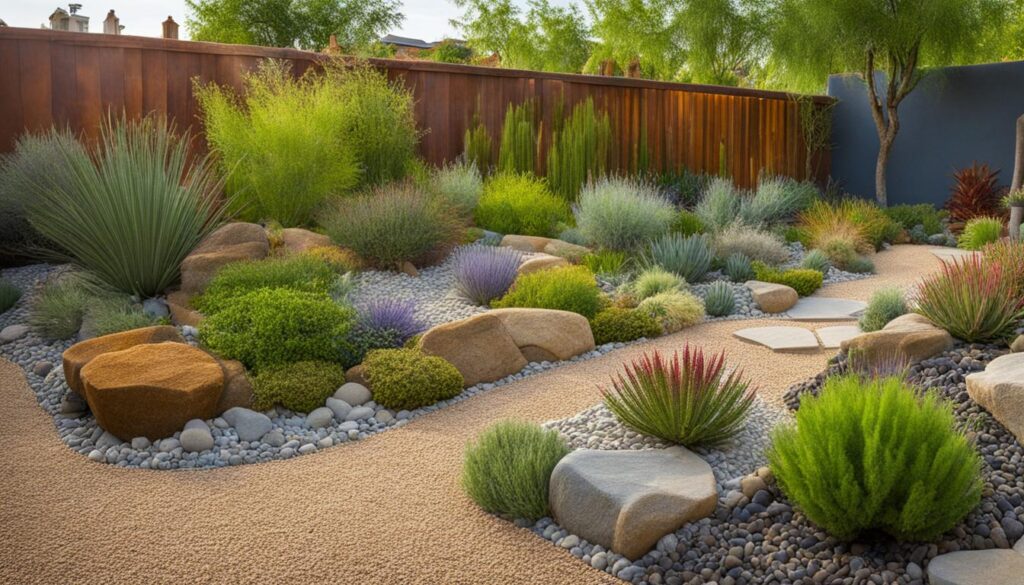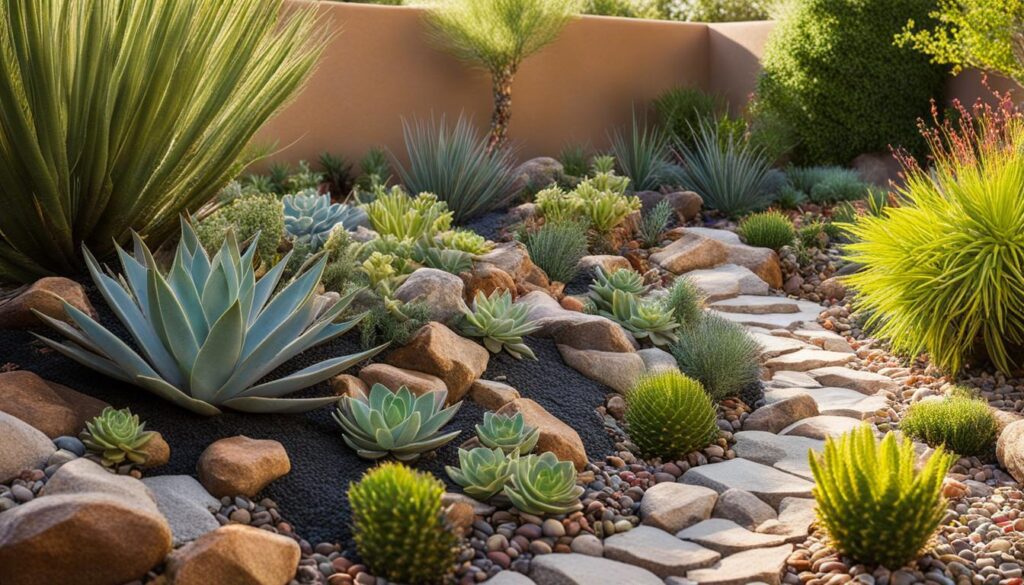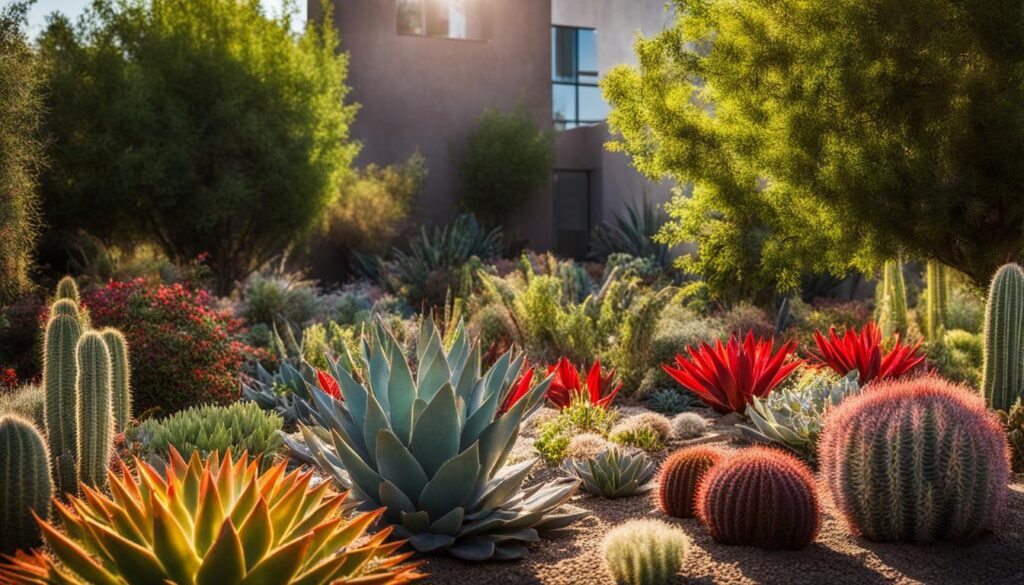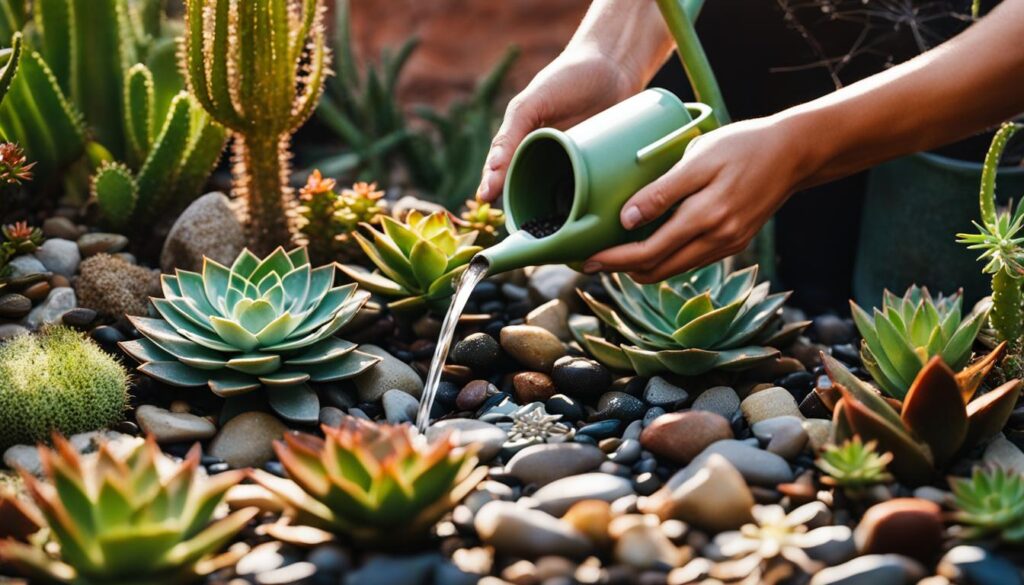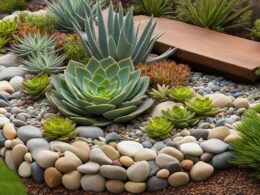Are you looking to transform your small outdoor space into a sustainable and vibrant oasis? Look no further! Our comprehensive guide will teach you the art of urban xeriscaping, a landscape design technique that focuses on creating water-wise yards in limited spaces. By incorporating drought-tolerant plants and strategic design principles, you can enjoy a beautiful and eco-friendly garden without compromising on aesthetics.
Urban xeriscaping is all about maximizing the use of low-water-use or drought-tolerant plants to create a lush and sustainable landscape. Whether you have a tiny balcony, rooftop garden, or a compact backyard, this technique allows you to make the most of your space while conserving water resources. Say goodbye to high water bills and hello to a greener way of gardening!
Key Takeaways:
- Urban xeriscaping is a landscaping technique that focuses on creating water-wise yards in small spaces.
- By choosing drought-tolerant plants and strategic design principles, you can create a sustainable and vibrant garden.
- Xeriscaping helps conserve water, reduce water bills, and create a beautiful environment.
- Consider the specific conditions of your location when designing an urban xeriscape for small spaces.
- Choose drought-tolerant perennials and low-water usage trees for your xeriscape garden.
What is Xeriscaping and Why is it Important?
Xeriscaping is a landscaping technique that focuses on creating a water-wise yard by using plants that require little to no supplemental irrigation. It is particularly beneficial in arid and water-scarce regions, such as high-elevation and desert climates. By choosing drought-tolerant plants with natural water-storing capabilities and deep roots, you can create a landscape that requires minimal watering once established.
Xeriscaping is important for several reasons. Firstly, it helps conserve water, which is a precious resource. By reducing the amount of water needed for irrigation, xeriscaping can significantly lower water consumption and contribute to water conservation efforts. This is particularly crucial in areas facing water scarcity or where water restrictions are in place.
Furthermore, xeriscaping is a sustainable and eco-friendly landscaping approach. By selecting drought-tolerant plants, you can create a beautiful and vibrant yard without relying heavily on water resources. This not only reduces your environmental footprint but also saves you money on water bills in the long run.
“Xeriscaping allows you to enjoy a lush and vibrant garden even in water-scarce environments.”
In addition, xeriscaping enhances the resilience of your landscape. Drought-tolerant plants have adapted to survive in challenging conditions, making them more resistant to drought, heat, and other environmental stresses. By incorporating these plants into your xeriscape design, you can create a yard that thrives even during periods of water scarcity or extreme weather conditions.
Overall, xeriscaping is a smart and sustainable landscaping choice, particularly for small spaces. It reduces water usage, promotes environmental conservation, and creates a visually appealing and low-maintenance landscape that can withstand challenging climates.
Designing an Urban Xeriscape for Small Spaces
When it comes to designing an urban xeriscape for small spaces, there are several key factors to consider. By taking into account the specific conditions of your location, you can create a sustainable and vibrant garden that thrives in limited space.
Understanding Your Climate and Light Levels
The first step in designing your urban xeriscape is to understand the climate and light levels of your area. Determine your Hardiness Zone to identify the plants that will thrive in your specific climate. Additionally, track the amount of sun your space receives throughout the day, as this will help you select plants that are suitable for the light levels in your garden.
Improving Soil Quality
Creating healthy soil is essential for a successful urban xeriscape. Start by adding organic matter such as compost, peat, and aged manure to improve the water-holding capacity of the soil. This will help promote root growth and enhance the overall health of your plants. Mix these amendments into the existing soil to create a nutrient-rich foundation for your xeriscape garden.
Strategic Plant Placement and Water Conservation
Mapping out your small space to scale is crucial for efficient plant placement. Consider the watering needs of each plant and group them accordingly. This will prevent over or under-watering and ensure optimal growth. Additionally, strategically placing shade structures, such as trellises or pergolas, can help reduce water evaporation and provide relief for sun-sensitive plants. Mulching the soil is another effective way to conserve water in an urban xeriscape garden by minimizing moisture evaporation and suppressing weed growth.
Choosing the Right Plants for Urban Xeriscaping
When it comes to urban xeriscaping, selecting the right plants is crucial for creating a sustainable and low-water usage garden. By choosing drought-tolerant perennials and low-water usage trees, you can ensure a vibrant and thriving landscape that requires minimal maintenance and watering.
Choosing Drought-Tolerant Perennials
Drought-tolerant perennials are an excellent choice for urban xeriscaping. These plants have adapted to survive in dry environments and require minimal water once established. Some popular options include:
- Agastache: Also known as hummingbird mint, this plant produces vibrant blooms and attracts pollinators.
- Artemisia: With its silver foliage, this plant adds texture and depth to the landscape.
- Coneflower: A native wildflower, coneflowers come in a variety of colors and are highly drought-tolerant.
- Coreopsis: These bright and cheerful flowers are not only drought-tolerant but also attract butterflies to your garden.
- Ornamental Grasses: Grasses like feather reed grass and blue oat grass add movement and beauty to your xeriscape garden.
Low-Water Usage Trees
Incorporating low-water usage trees into your urban xeriscape can provide shade and add visual interest to your landscape. These trees are adapted to arid conditions and require minimal watering once they are established. Consider these options for your garden:
- Acacia: Acacia trees have delicate foliage and provide a beautiful canopy of shade.
- Blue Spruce: This evergreen tree is known for its striking blue needles and can tolerate dry conditions.
- Desert Willow: With its trumpet-shaped flowers and drought tolerance, the desert willow is a great addition to any xeriscape garden.
- Olive: Olive trees are not only drought-tolerant but also produce a harvest of delicious fruits.
By carefully selecting drought-tolerant perennials and low-water usage trees, you can create a beautiful and environmentally-friendly urban xeriscape that thrives in small spaces. These plants not only require less water but also provide habitat for pollinators and wildlife, making them a sustainable choice for any garden.
Can the Techniques for Urban Xeriscaping be Applied to Suburban Areas as Well?
Yes, the techniques for urban xeriscaping can easily be applied to suburban areas as well. With the growing trend of green suburban xeriscaping conversion, homeowners in suburban areas are embracing water-efficient landscaping methods to conserve resources and create beautiful, sustainable outdoor spaces.
Maintaining and Watering Your Urban Xeriscape
Once you have designed and implemented your urban xeriscape, it is important to properly maintain and water your plants to ensure their health and longevity. While xeriscaping plants are low-maintenance once established, they still require some care and attention to thrive in your small space. Here are some tips to help you maintain your urban xeriscape garden.
Regular Watering During Establishment
“During the first year or two, it is crucial to water your xeriscaping plants regularly to promote proper root establishment,” says gardening expert Lisa Johnson. “This will help them develop deep root systems that can reach out to find their own water sources.”
Water your newly planted xeriscaping plants once or twice a week, providing enough water to moisten the soil to a depth of 6-8 inches. Monitor the weather conditions and adjust your watering schedule accordingly. If there is rainfall, you may need to reduce or skip watering to avoid overwatering.
Minimize Watering After Establishment
Once your xeriscaping plants are established, they can handle periods of drought with minimal watering. These plants are adapted to conserve water, so avoid overwatering, as it can lead to root rot and other problems. Only water your xeriscape garden when necessary, such as during extended heat or prolonged dry periods. A deep watering once every 2-3 weeks is often sufficient.
Mulching and Pruning
Applying a layer of mulch around your xeriscaping plants can help minimize moisture evaporation and keep the soil cool. Use organic mulch, such as wood chips or straw, and spread it evenly around the base of your plants. This will also help suppress weed growth and improve the overall aesthetics of your xeriscape garden.
Regular pruning and deadheading may be necessary to maintain the shape and promote blossoming of flowering plants in your xeriscape garden. Remove any dead or damaged branches, and prune back overgrown foliage to encourage healthy growth. Consult plant-specific pruning guidelines for the best results.
With proper maintenance and watering, your urban xeriscape can continue to thrive and provide you with a beautiful, water-wise garden for years to come.
Conclusion
Urban xeriscaping is a fantastic option for creating an eco-friendly and sustainable landscape in small spaces. By implementing this landscaping technique, you can reduce water usage while still enjoying a vibrant and beautiful yard. With the right knowledge and plant selection, you can master the art of urban xeriscaping and contribute to a greener world.
Remember, xeriscaping is all about choosing drought-tolerant plants that are well-suited for your climate and location. These plants have the ability to store water and thrive with minimal supplemental irrigation. By designing your xeriscape to optimize water conservation, such as using shade structures and mulching, you can further reduce your water consumption and create a more sustainable environment.
Proper maintenance and watering are key to the success of your xeriscape garden. While xeric plants are low-maintenance once established, they still require attention during their initial growth stages. Regular watering during the first year or two is crucial for root establishment. After that, they can handle periods of drought with minimal watering. Mulching the soil and regular pruning will also help maintain the health and beauty of your xeriscape plants.
Embrace the beauty and benefits of urban xeriscaping. By making eco-friendly landscaping choices, you can create a lush and water-wise yard that not only enhances your living space but also contributes to a more sustainable future.






